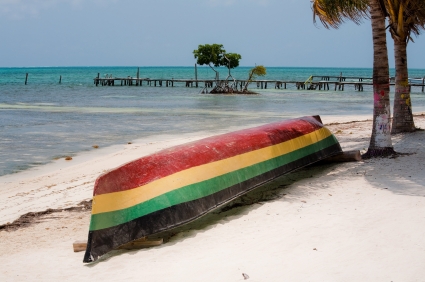Rastafarianism
Is It A Religion Or Something Else
The characteristic or identifying
colors of Rastafarianism are red, black, green and gold. Once you're
in Jamaica you will notice these colors are visible practically
everywhere, on braided belts, caps, houses and even on boats.

The Early Days of Rastafarian
In the early days of Rastafarian, the mainstream
society of Jamaica looked upon the Rasta communities as drug-crazed
individuals that were planning to undermine the government.
But
a degree of respectability began to develop after politician Norman
Manley visited Haile Selassie in Ethiopia and was presented with a
sacred rod that helped him win the 1972 elections with the support of
Rastas and their allies.
The Rasta
movement, as it sometimes called, has its roots in the teachings of
Marcus Garvey (1887 - 1940), a Jamaican national hero who prophetically
advised his followers to look to Africa where a Black King shall be
crowned.
His prediction
did come to pass in 1930 when Ras Tafari Makonnen (Ras is an honorific
given to royalty, Tafari his family name) was crowned Negus of Ethiopia,
taking the title Emperor Haile Selassie, King of Kings, Lord of Lords,
Conquering Lion of the Tribe of Judah.
When you read the Scriptures it seems to support this claim to divinity.
Their Faith And Beliefs

Rastafarian faith is based on the belief that Rastas
are one of the lost tribes of Israel and as you know they smoke
marijuana (ganja or herb) as a religious sacrament as outlined in Psalm
104:14.
The Psalm reads "he causes the grass to grow for the cattle and the herb for the service of man".
Smoking this sacred herb at communal time, is said to bring on a meditative spirit or take them to higher level of spirituality.
Rastafarianism Respectability Solidify

The international success of Bob Marley and the Wailers, whose reggae music spread the word about Rastas beliefs made Jamaica a trendy place to
|
|
| Rastafarian is a social, political, and religious movement that began on the Caribbean island of Jamaica
in the late 1920s. Followers of the movement, sometimes called Rastas
or Dreads, are best known for their connection to the popular musical
style reggae; their extensive ritual use of ganja (marijuana); and
for wearing their hair in long, rope-like braids called dreadlocks. The name Rastafari is borrowed from Ras Tafari, the precoronation name for former Ethiopian emperor Haile Selassie I (1892–1975), who was in power from 1916 to 1974 (though he began his formal reign in 1930). At the time, Selassie was the most prominent black African king in the world, and he gained international fame for his elaborate 1930 coronation and eloquent opposition to the Italian invasion of Ethiopia in 1935. Although a number of the founders of Rastafari (notably Leonard Howell and Archibald Dunckley) preached that Selassie was a living god, the emperor himself remained a devout leader within the Ethiopian Orthodox Tewahedo Church. When Selassie visited Jamaica in 1966, he was greatly puzzled by Rastafarians who seemed to be worshipping him. Although there are many variants within Rastafari, the 1983 Rastafari Theocratic Assembly passed a resolution declaring a single variant—that associated with the House of Nyahbinghi—to be the orthodox faith. The House of Nyahbinghi creed proclaims Selassie to be the living god and states that all African peoples are one and that the descendants of those who were taken from Africa to be slaves in "Babylon" will one day be repatriated. It is contended that all African people are descendants of the ancient Hebrews and that the reason Africans now live outside of Africa is because their descendants disobeyed Jah (short for Jehovah, the God of the Hebrews), who then punished them by making them slaves to Europeans. Selassie was expected to arrange for the return of all people of African descent to Africa, but following his death in 1975, there has been less emphasis on a physical return to Africa and greater emphasis on a spiritual return. Rastafari today is a worldwide movement with membership in Jamaica, other Caribbean islands, the United States, Canada, Australia, New Zealand, South Africa, Ghana, Ethiopia, the islands of the South Pacific, and parts of Western Europe (especially the United Kingdom, the Netherlands, and Germany). Although contemporary Rastas represent many races and nationalities, the religion began as a Black nationalist movement. Contemporary adherents stress that it is much more than a nationalist movement—it is a way of life. They prefer to describe their involvement with Rastafari as levity, the adoption of a lifestyle informed by strict theocratic principles. One central Rasta ritual, called "reasoning," involves a group discussion and debate about the interpretation of biblical texts, local politics, predictions about the future, and commentary on world events. During these ceremonies Rastas also smoke ganja, which, they believe, brings them closer to Jah. The smoking of ganja is thought to have medicinal as well as spiritual benefits. Rastafari is a highly successful religious movement that has persisted for more than 70 years. It continues to play a major part in the struggles of people of African descent for freedom and equality throughout the world, particularly in the Caribbean. It is a highly decentralized movement that includes a variety of organizations (mostly local), publications, and self-initiated activities. |
No comments:
Post a Comment